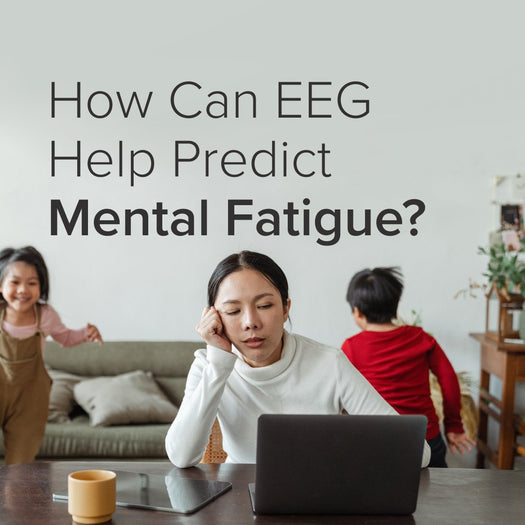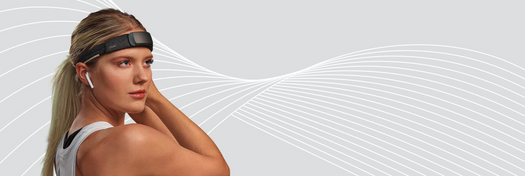Mental Fatigue Is Costly. A New Study Shows How EEG Could Help Predict It.

Over the past decade, we’ve seen a surge in low-cost, wearable technology that allows us to track everything from our heart rate to deep sleep. No longer relegated to big, clunky machines in sleep labs, electroencephalography technology (EEG)—which gives you real-time feedback on your brain activity—is now conveniently tucked inside mobile devices like Muse S headbands. This allows researchers to track brain data they can’t get in traditional lab settings, like when participants are walking or riding a bike. A recent study revealed that not only are mobile EEG monitoring devices (mEEG) fast and accurate, but they can give us insight into our brain’s performance and how to optimize it.

Mental Fatigue and Its Effects
We all know what cognitive (or mental) fatigue feels like. It’s as if our brain just isn’t working and even the simplest tasks feel impossible. And that’s exactly what happens. Studies show cognitive fatigue has a negative effect on brain performance by affecting our normal ability to pay attention, make decisions, and detect errors. The result? More mistakes as well as an increased number of accidents while driving, flying, operating heavy machinery, making medical decisions, et cetera (1).

Despite the many detrimental effects of cognitive fatigue (and how common it is), it’s been tough to assess up until now due to challenges with self-reporting and detecting reliable biomarkers. As a result, there’s been a lot of incentive to develop and validate other ways to detect its onset in the brain to help with prevention and treatment.
How Muse EEG Could Help Predict Mental Fatigue
To get a closer look at what cognitive fatigue looks like in the brain, neuroscientist Olav E. Krigolson and his colleagues at the University of Victoria, University of Calgary and University of British Columbia Okanagan, came up with an idea. First, they hypothesized that they could use a Muse mEEG headband to accurately monitor participants’ biomarkers such as human-event related brain potentials (ERPs) and brain wave activity (EEG), and second, that these biomarkers would show a relationship with perceived and behavioral measures of cognitive fatigue (1).

Image: In labs, EEG electrodes are placed externally along the scalp in the above regions using adhesive. This method is costly and takes more time to set up compared to Muse EEG devices.
Krigolson and his colleagues felt confident in the accuracy of the mEEG device, as they had proven it in a study four years earlier. At that time, the scientific community had doubted the quality of data in low-cost, mobile EEG devices. But Krigolson’s 2017 study revealed that they could record mEEG data using a Muse headband and the data was comparable to what they would get from a research-grade system (2). Later studies showed mEEG could also accurately measure ERP (3).
So for this study, the team used the mEEG to record the ongoing electrical activity in the brain as well as to record ERPs. They did this by giving each participant different stimuli to respond to, like written words or letters, pictures, or sounds, and measuring their response. The theory was that by looking at the brain’s response to these different stimuli, they could learn how the brain processes different types of information (1).

For the study, they assembled a group of 1,000 men and women (one of the largest study samples used for cognitive fatigue research of this kind) from across British Columbia, Canada ranging in age from 18 to 62. They asked each to perform a random task on an Apple iPad while the team recorded their brain waves. Here’s what they found.
What the Research Team Discovered
The first thing the team discovered was that the whole process using a mEEG device was significantly faster than traditional EEG recordings. For setup and data collection, the headband clocked in at less than 7 minutes per participant, while traditional EEG recordings might take up to 20-40 minutes (4). Watch more about how EEG and ERP work together to give us a better understanding of how our brain responds to the stimulus below.
An analysis of their data revealed that the combined use of EEG and ERP data was a better predictor of perceived cognitive fatigue and is a viable biomarker for it. For example, cognitive fatigue increased theta brain waves (between 4-8Hz), the slow waves associated with sleep, and reduced consciousness. It also showed some increase in delta brain waves (.5-4 Hz), the slowest wave associated with deep sleep and loss of body awareness.
In addition, the study found a number of ERP biomarkers, namely a reduction in the P300—the component studies show diminishes when cognitive fatigue sets in. Not only did the study show that the individual EEG and ERP data is useful to predict a drowsy brain, but it also provided evidence that the two together are more powerful and could even predict the impact of conditions such as a concussion on brain cognitive functioning (1).
The impacts of studies like this are profound. Not only can portable EEG devices help us learn how we rest best and find our focus in meditation, but they’re increasingly being used to measure brain health and performance in more clinical applications. Being able to observe more clearly how cognitive fatigue affects our brain and performance can inform best practices for how we work, organize our days, and plan for the future.
References:
